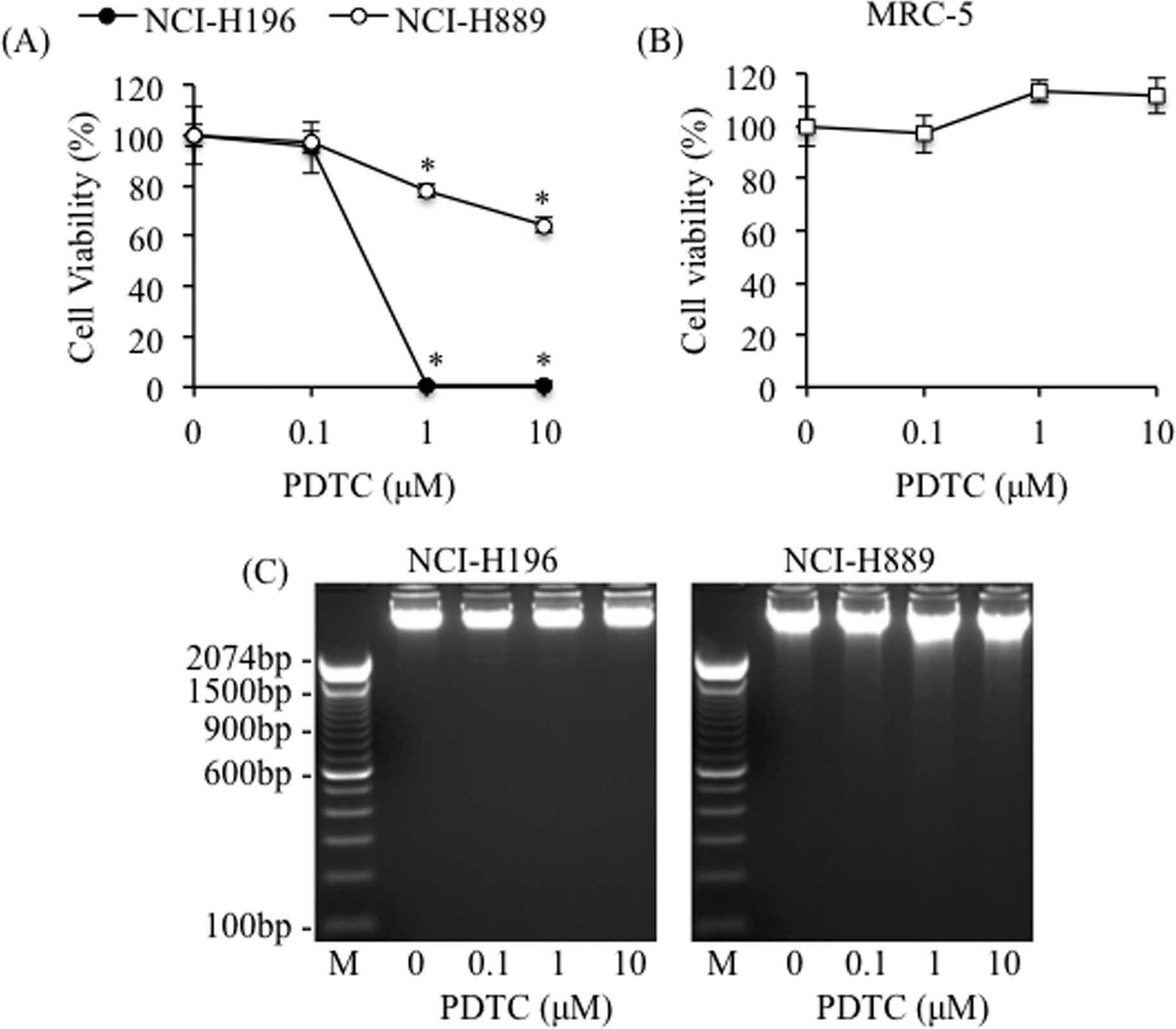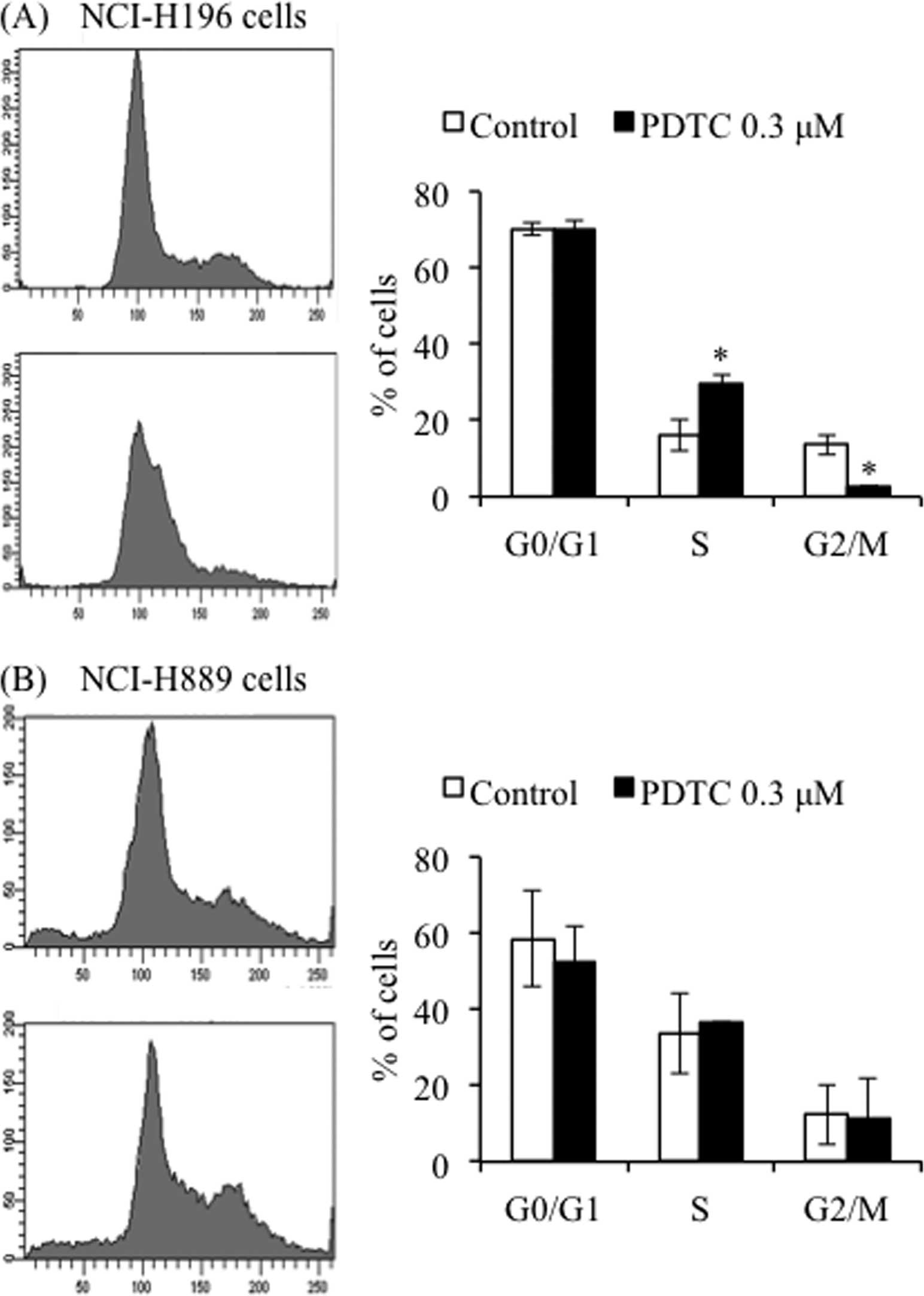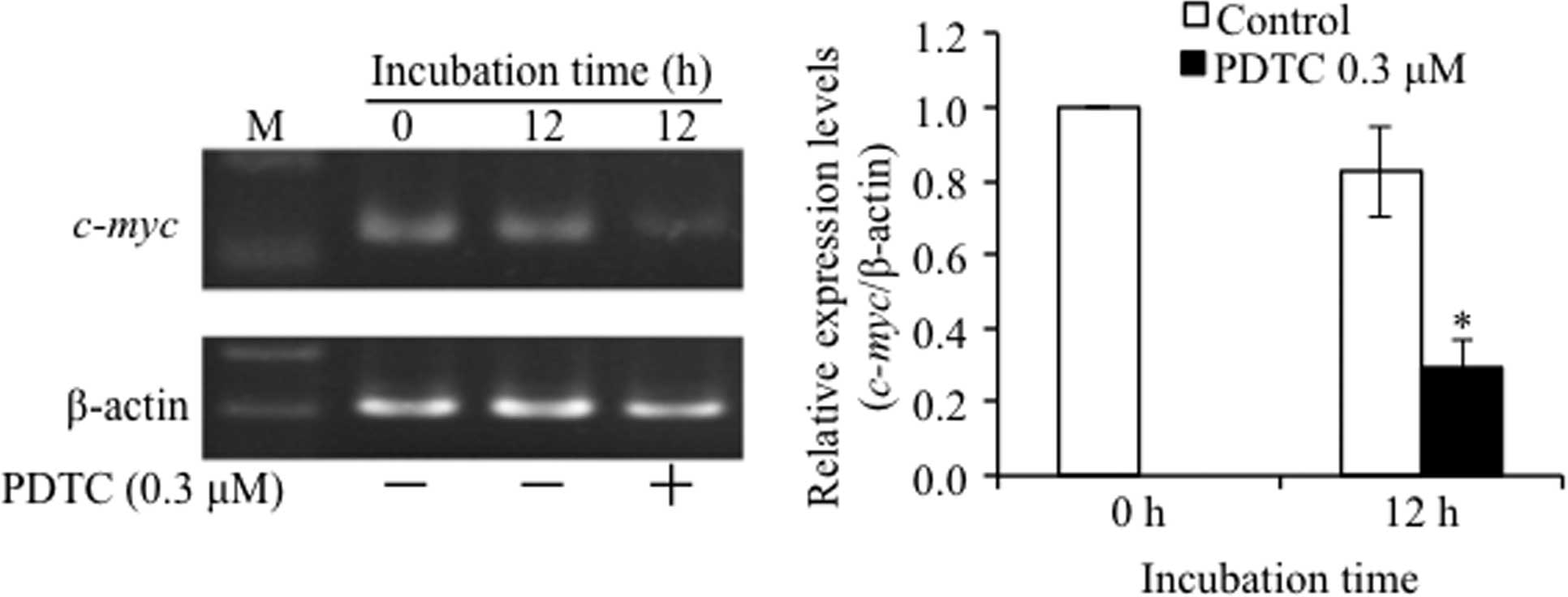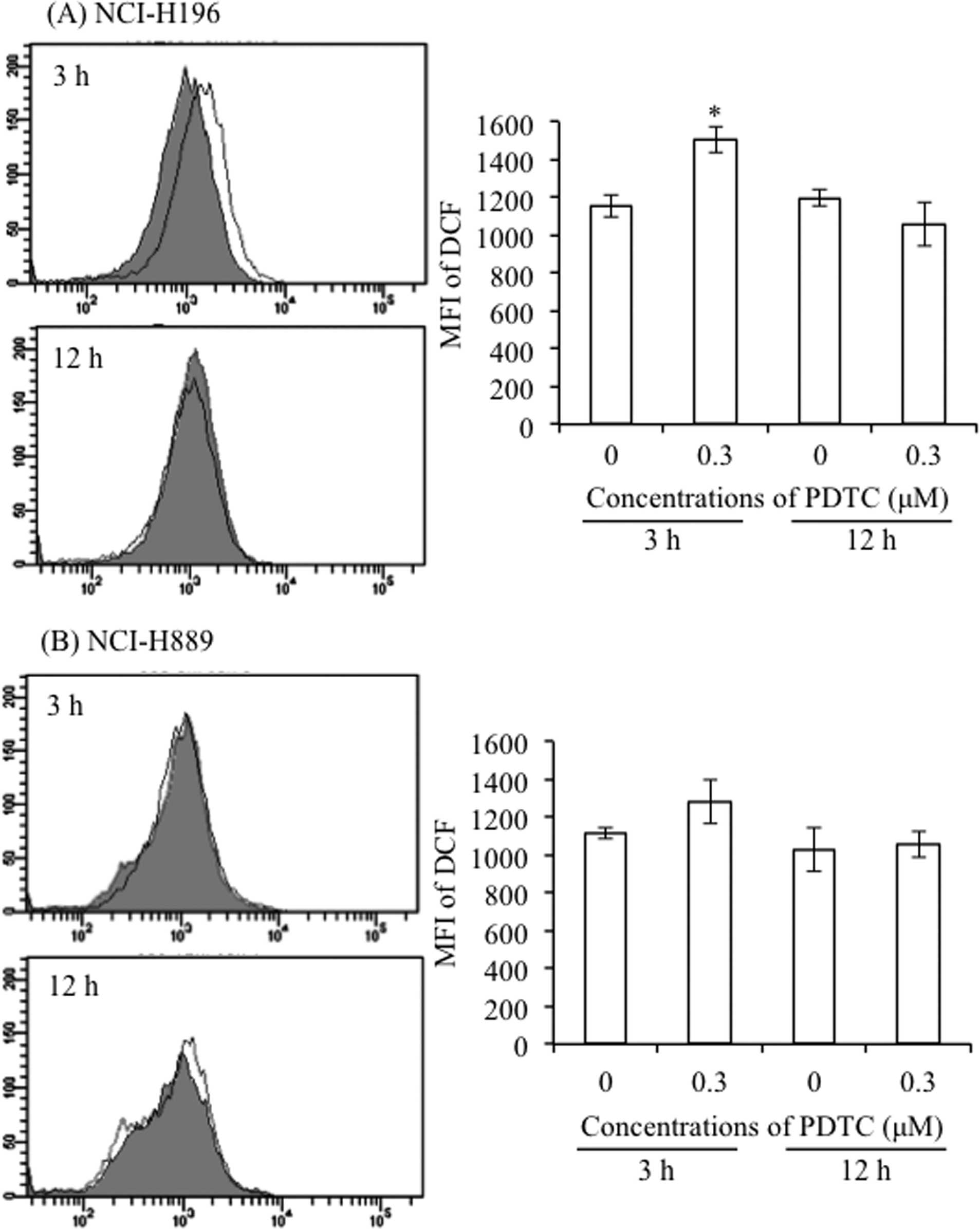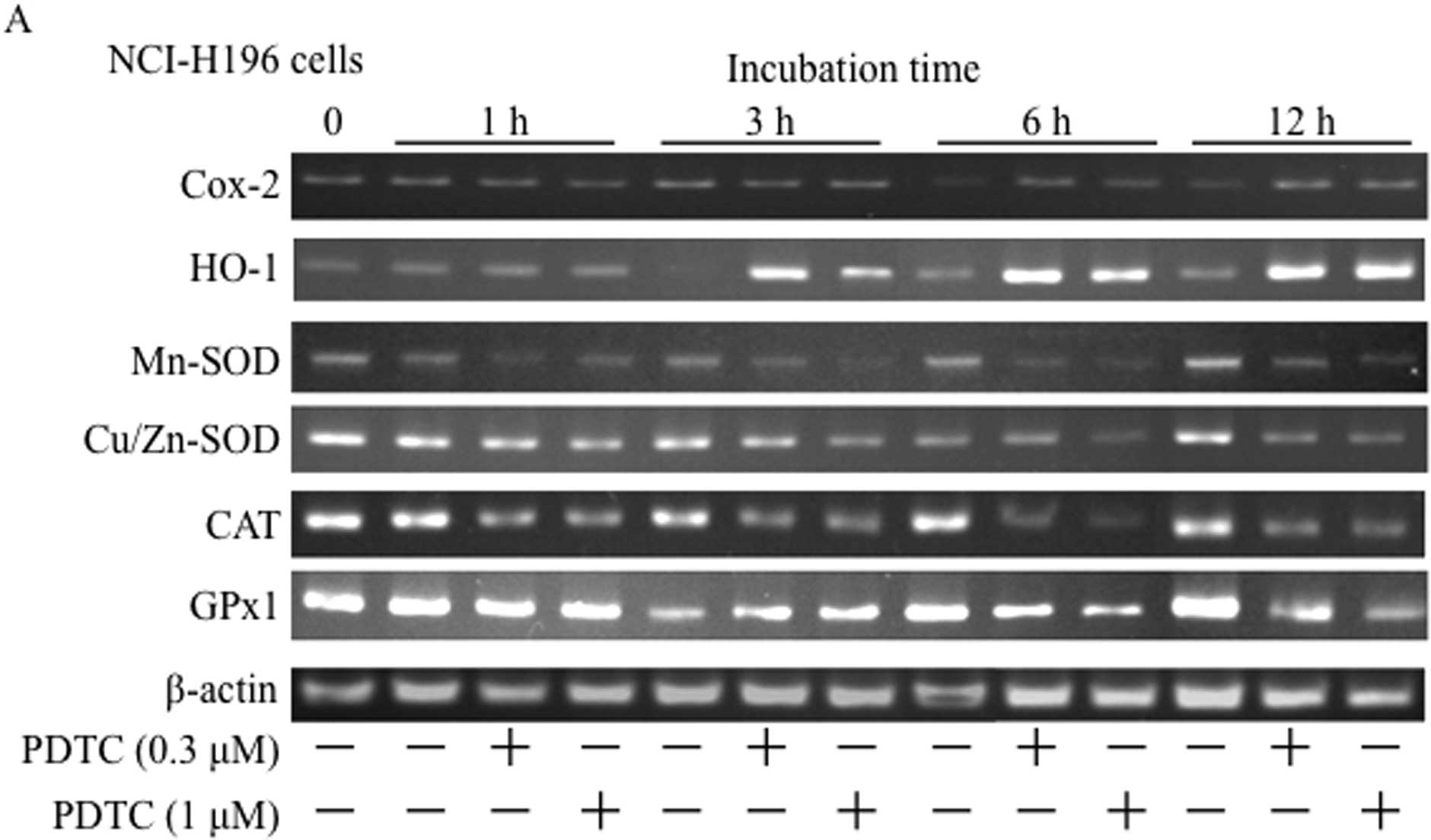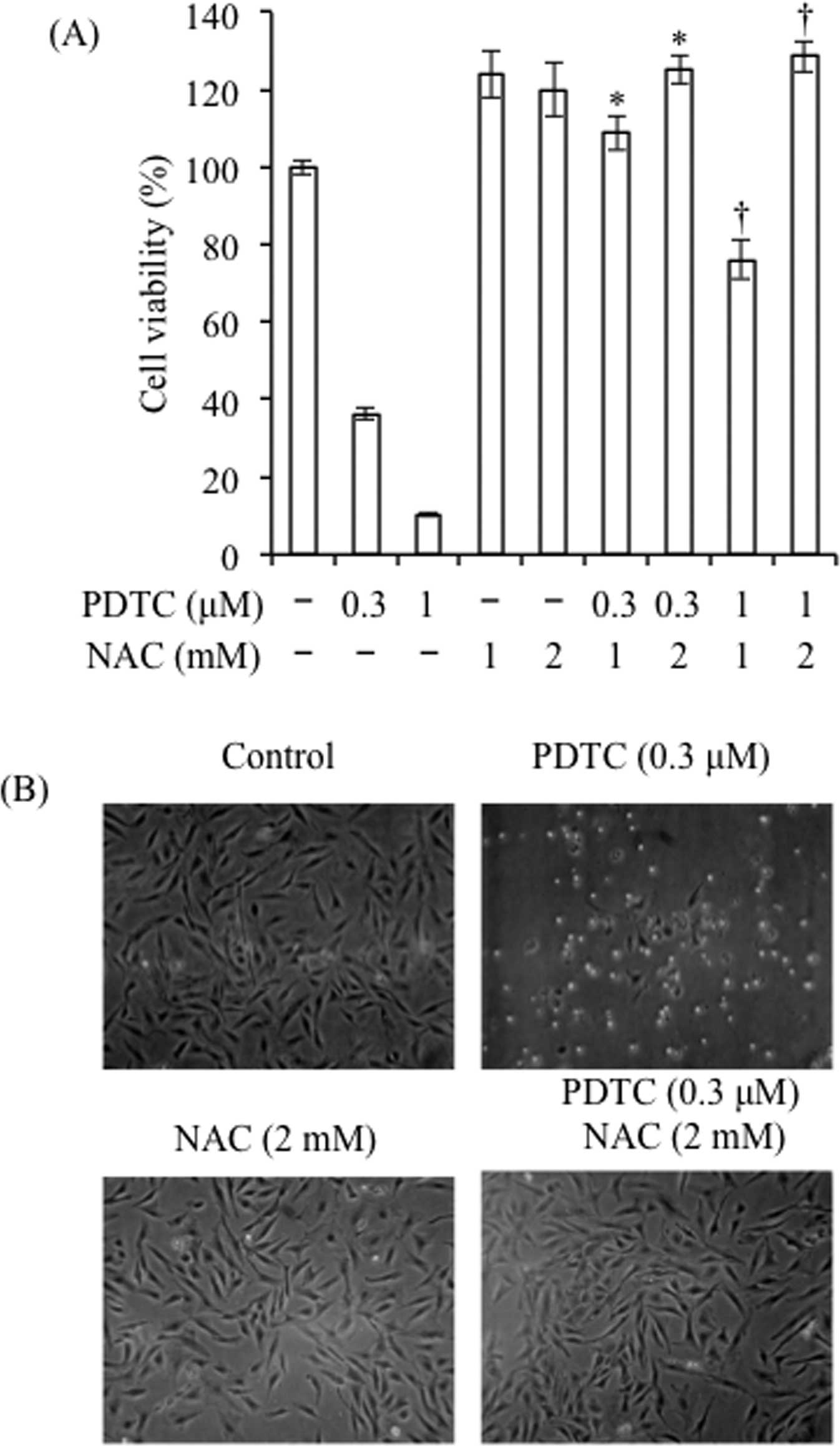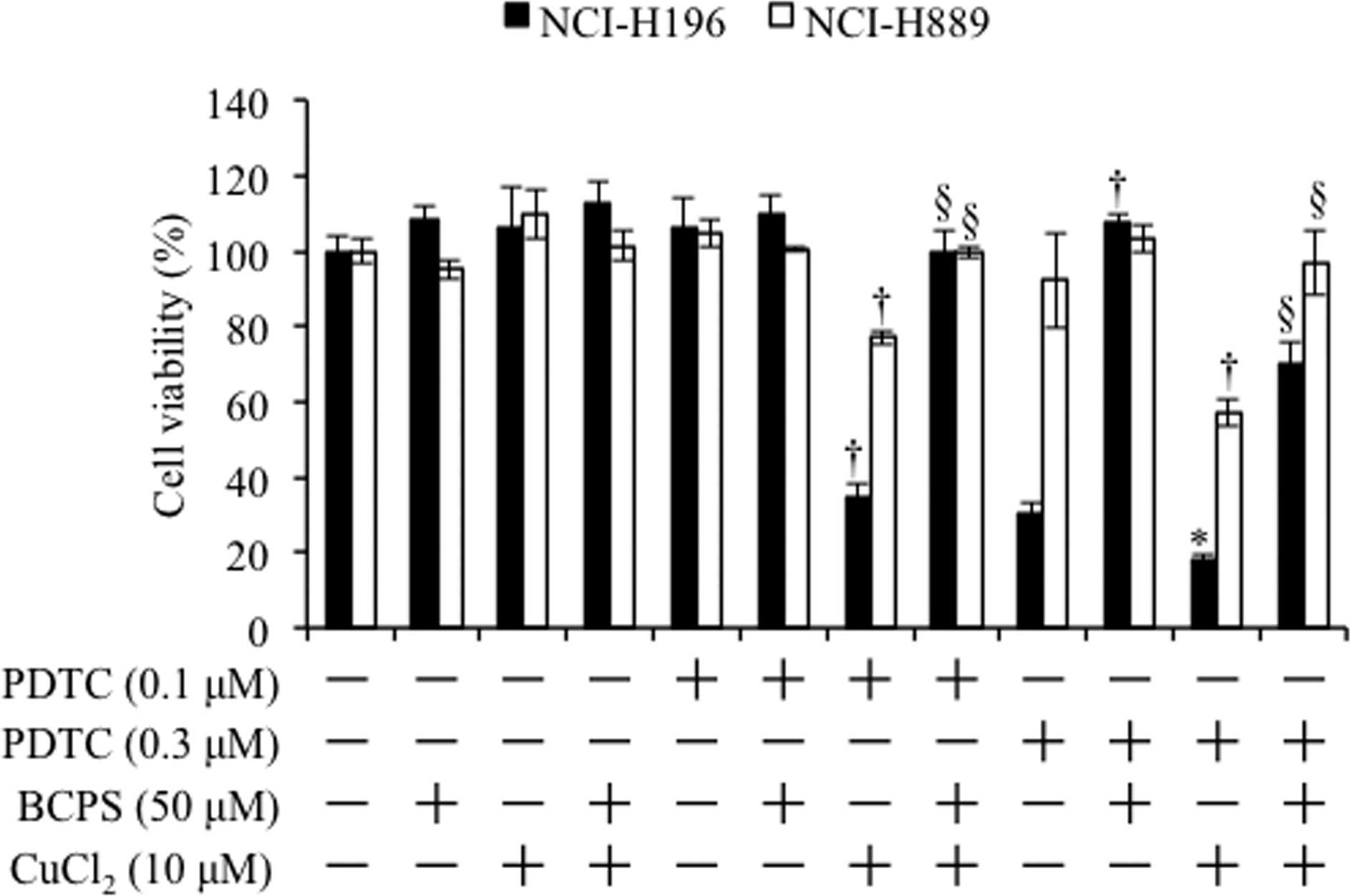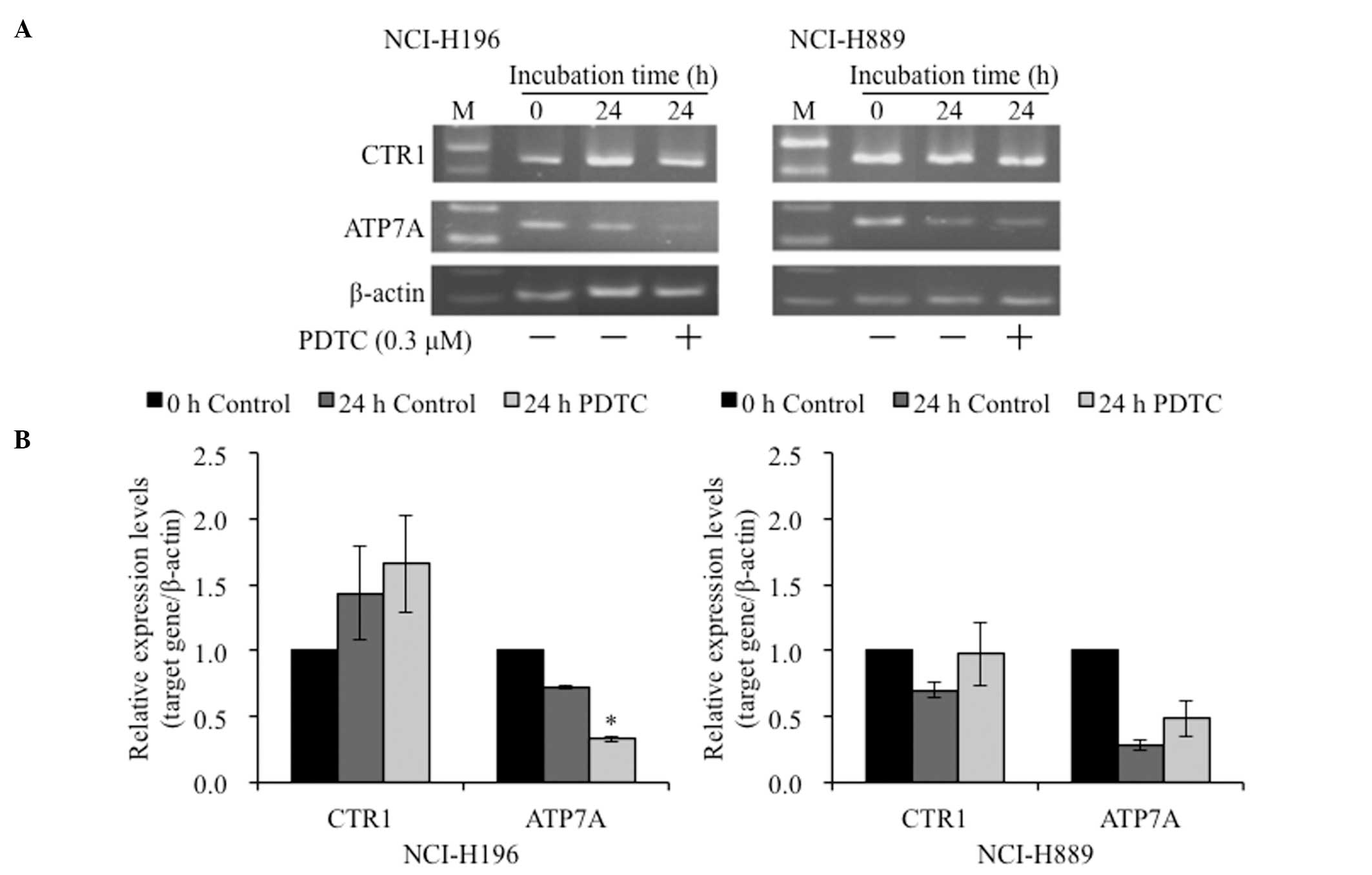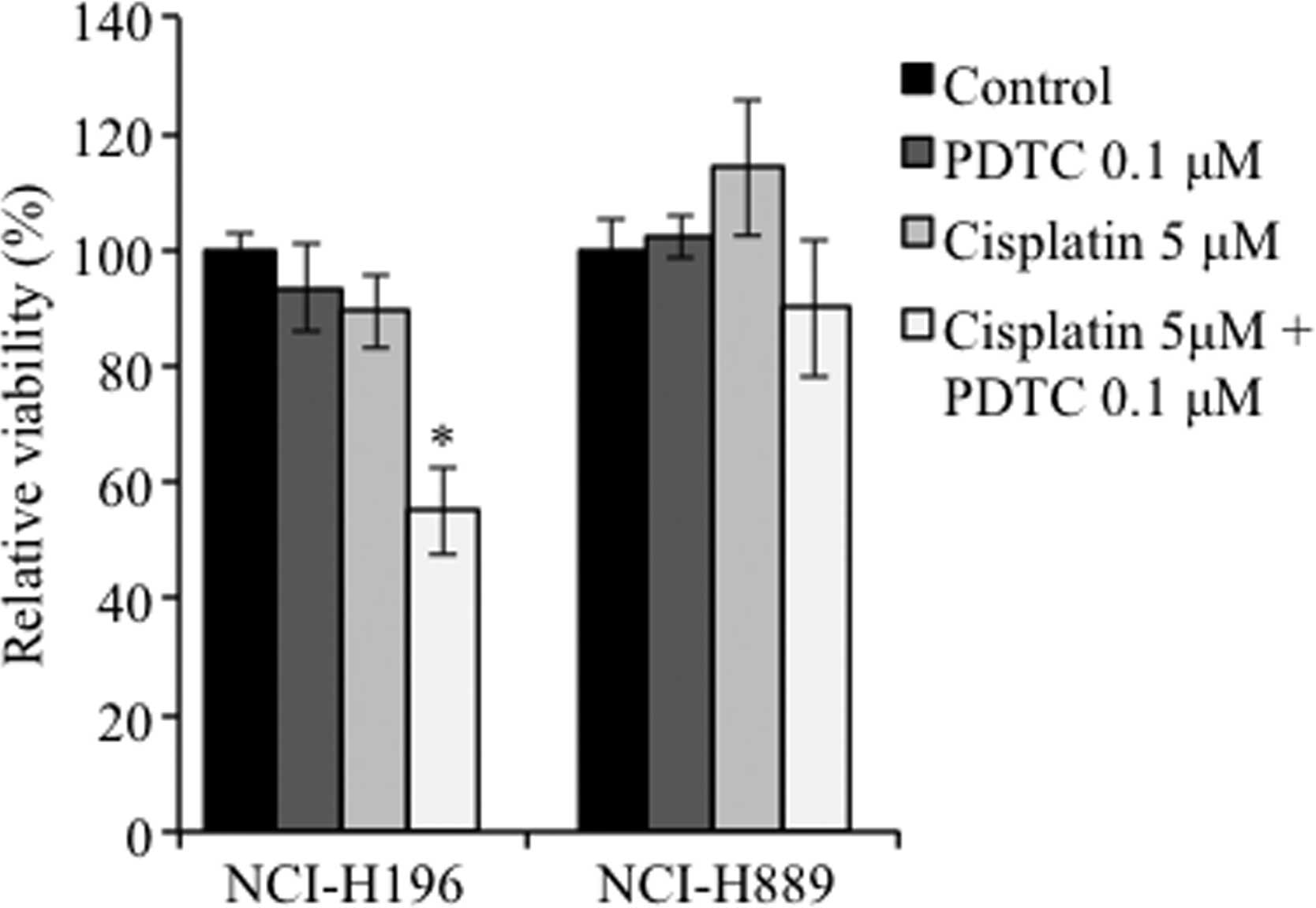|
1
|
Chan BA and Coward JI: Chemotherapy
advances in small-cell lung cancer. J Thorac Dis. 5:S565–S578.
2013.PubMed/NCBI
|
|
2
|
van Meerbeeck JP, Fennell DA and De
Ruysscher DK: Small-cell lung cancer. Lancet. 378:1741–1755.
2011.
|
|
3
|
Jackman DM and Johnson BE: Small-cell lung
cancer. Lancet. 366:1385–1396. 2005. View Article : Google Scholar : PubMed/NCBI
|
|
4
|
Chinery R, Brockman JA, Peeler MO, Shyr Y,
Beauchamp RD and Coffey RJ: Antioxidants enhance the cytotoxicity
of chemotherapeutic agents in colorectal cancer: a p53-independent
induction of p21WAF1/CIP1 via C/EBPbeta. Nat Med.
3:1233–1241. 1997. View Article : Google Scholar : PubMed/NCBI
|
|
5
|
Herrmann JL, Beham AW, Sarkiss M, et al:
Bcl-2 suppresses apoptosis resulting from disruption of the
NF-kappa B survival pathway. Exp Cell Res. 237:101–109. 1997.
View Article : Google Scholar : PubMed/NCBI
|
|
6
|
Chen SH, Liu SH, Liang YC, Lin JK and
Lin-Shiau SY: Death signaling pathway induced by pyrrolidine
dithiocarbamate-Cu(2+) complex in the cultured rat cortical
astrocytes. Glia. 31:249–261. 2000. View Article : Google Scholar : PubMed/NCBI
|
|
7
|
Forman HJ, York JL and Fisher AB:
Mechanism for the potentiation of oxygen toxicity by disulfiram. J
Pharmacol Exp Ther. 212:452–455. 1980.PubMed/NCBI
|
|
8
|
Goldstein BD, Rozen MG, Quintavalla JC and
Amoruso MA: Decrease in mouse lung and liver glutathione peroxidase
activity and potentiation of the lethal effects of ozone and
paraquat by the superoxide dismutase inhibitor
diethyldithiocarbamate. Biochem Pharmacol. 28:27–30. 1979.
View Article : Google Scholar
|
|
9
|
Nobel CI, Kimland M, Lind B, Orrenius S
and Slater AF: Dithiocarbamates induce apoptosis in thymocytes by
raising the intracellular level of redox-active copper. J Biol
Chem. 270:26202–26208. 1995. View Article : Google Scholar
|
|
10
|
Donadelli M, Dalla Pozza E, Costanzo C, et
al: Increased stability of P21(WAF1/CIP1) mRNA is required for
ROS/ERK-dependent pancreatic adenocarcinoma cell growth inhibition
by pyrrolidine dithiocarbamate. Biochim Biophys Acta. 1763:917–926.
2006. View Article : Google Scholar : PubMed/NCBI
|
|
11
|
Chen SH, Lin JK, Liang YC, Pan MH, Liu SH
and Lin-Shiau SY: Involvement of activating transcription factors
JNK, NF-kappaB, and AP-1 in apoptosis induced by pyrrolidine
dithiocarbamate/Cu complex. Eur J Pharmacol. 594:9–17. 2008.
View Article : Google Scholar : PubMed/NCBI
|
|
12
|
Morais C, Gobe G, Johnson DW and Healy H:
Inhibition of nuclear factor kappa B transcription activity drives
a synergistic effect of pyrrolidine dithiocarbamate and cisplatin
for treatment of renal cell carcinoma. Apoptosis. 15:412–425. 2010.
View Article : Google Scholar
|
|
13
|
Venkatraman M, Anto RJ, Nair A, Varghese M
and Karunagaran D: Biological and chemical inhibitors of NF-kappaB
sensitize SiHa cells to cisplatin-induced apoptosis. Mol Carcinog.
44:51–59. 2005. View
Article : Google Scholar : PubMed/NCBI
|
|
14
|
Evans WK, Shepherd FA, Feld R, Osoba D,
Dang P and Deboer G: VP-16 and cisplatin as first-line therapy for
small-cell lung cancer. J Clin Oncol. 3:1471–1477. 1985.PubMed/NCBI
|
|
15
|
Sundstrom S, Bremnes RM, Kaasa S, et al:
Cisplatin and etoposide regimen is superior to cyclophosphamide,
epirubicin, and vincristine regimen in small-cell lung cancer:
results from a randomized phase III trial with 5 years’ follow-up.
J Clin Oncol. 20:4665–4672. 2002.PubMed/NCBI
|
|
16
|
Safaei R: Role of copper transporters in
the uptake and efflux of platinum containing drugs. Cancer Lett.
234:34–39. 2006. View Article : Google Scholar : PubMed/NCBI
|
|
17
|
Samimi G, Safaei R, Katano K, et al:
Increased expression of the copper efflux transporter ATP7A
mediates resistance to cisplatin, carboplatin, and oxaliplatin in
ovarian cancer cells. Clin Cancer Res. 10:4661–4669. 2004.
View Article : Google Scholar : PubMed/NCBI
|
|
18
|
Safaei R, Katano K, Samimi G, et al:
Cross-resistance to cisplatin in cells with acquired resistance to
copper. Cancer Chemother Pharmacol. 53:239–246. 2004. View Article : Google Scholar : PubMed/NCBI
|
|
19
|
Inoue Y, Matsumoto H, Yamada S, et al:
Association of ATP7A expression and in vitro sensitivity to
cisplatin in non-small cell lung cancer. Oncol Lett. 1:837–840.
2010.
|
|
20
|
Li ZH, Qiu MZ, Zeng ZL, et al:
Copper-transporting P-type adenosine triphosphatase (ATP7A) is
associated with platinum-resistance in non-small cell lung cancer
(NSCLC). J Transl Med. 10:212012. View Article : Google Scholar : PubMed/NCBI
|
|
21
|
Song L, Li Y, Li W, Wu S and Li Z: miR-495
enhances the sensitivity of non-small cell lung cancer cells to
platinum by modulation of copper-transporting P-type adenosine
triphosphatase A (ATP7A). J Cell Biochem. 115:1234–1242. 2014.
View Article : Google Scholar : PubMed/NCBI
|
|
22
|
Imai M, Kikuchi H, Denda T, Ohyama K,
Hirobe C and Toyoda H: Cytotoxic effects of flavonoids against a
human colon cancer derived cell line, COLO 201: a potential natural
anticancer substance. Cancer Lett. 276:74–80. 2009. View Article : Google Scholar
|
|
23
|
Yuan B, Ohyama K, Bessho T and Toyoda H:
Contribution of inducible nitric oxide synthase and
cyclooxygenase-2 to apoptosis induction in smooth chorion
trophoblast cells of human fetal membrane tissues. Biochem Biophys
Res Commun. 341:822–827. 2006. View Article : Google Scholar
|
|
24
|
Kikuchi H, Yuan B, Yuhara E, Takagi N and
Toyoda H: Involvement of histone H3 phosphorylation through p38
MAPK pathway activation in casticin-induced cytocidal effects
against the human promyelocytic cell line HL-60. Int J Oncol.
43:2046–2056. 2013.PubMed/NCBI
|
|
25
|
Kon A, Yuan B, Hanazawa T, et al:
Contribution of membrane progesterone receptor alpha to the
induction of progesterone-mediated apoptosis associated with
mitochondrial membrane disruption and caspase cascade activation in
Jurkat cell lines. Oncol Rep. 30:1965–1970. 2013.
|
|
26
|
Hu XM, Yuan B, Tanaka S, et al:
Involvement of oxidative stress associated with glutathione
depletion and p38 mitogen-activated protein kinase activation in
arsenic disulfide-induced differentiation in HL-60 cells. Leuk
Lymphoma. 55:392–404. 2014. View Article : Google Scholar
|
|
27
|
Obaya AJ, Mateyak MK and Sedivy JM:
Mysterious liaisons: the relationship between c-Myc and the cell
cycle. Oncogene. 18:2934–2941. 1999. View Article : Google Scholar : PubMed/NCBI
|
|
28
|
Zhang P, Li H, Wu ML, et al: c-Myc
downregulation: a critical molecular event in resveratrol-induced
cell cycle arrest and apoptosis of human medulloblastoma cells. J
Neurooncol. 80:123–131. 2006. View Article : Google Scholar
|
|
29
|
Payne CM, Bernstein C and Bernstein H:
Apoptosis overview emphasizing the role of oxidative stress, DNA
damage and signal-transduction pathways. Leuk Lymphoma. 19:43–93.
1995. View Article : Google Scholar : PubMed/NCBI
|
|
30
|
Keyse SM and Tyrrell RM: Heme oxygenase is
the major 32-kDa stress protein induced in human skin fibroblasts
by UVA radiation, hydrogen peroxide, and sodium arsenite. Proc Natl
Acad Sci USA. 86:99–103. 1989. View Article : Google Scholar : PubMed/NCBI
|
|
31
|
Keyse SM and Tyrrell RM: Both near
ultraviolet radiation and the oxidizing agent hydrogen peroxide
induce a 32-kDa stress protein in normal human skin fibroblasts. J
Biol Chem. 262:14821–14825. 1987.
|
|
32
|
Furuta S, Ortiz F, Zhu Sun X, Wu HH, Mason
A and Momand J: Copper uptake is required for pyrrolidine
dithiocarbamate-mediated oxidation and protein level increase of
p53 in cells. Biochem J. 365:639–648. 2002.PubMed/NCBI
|
|
33
|
Oltersdorf T, Elmore SW, Shoemaker AR, et
al: An inhibitor of Bcl-2 family proteins induces regression of
solid tumours. Nature. 435:677–681. 2005. View Article : Google Scholar : PubMed/NCBI
|
|
34
|
Olejniczak ET, Van Sant C, Anderson MG, et
al: Integrative genomic analysis of small-cell lung carcinoma
reveals correlates of sensitivity to bcl-2 antagonists and uncovers
novel chromosomal gains. Mol Cancer Res. 5:331–339. 2007.
View Article : Google Scholar
|
|
35
|
Malaguarnera L, Pilastro MR, DiMarco R, et
al: Cell death in human acute myelogenous leukemic cells induced by
pyrrolidinedithiocarbamate. Apoptosis. 8:539–545. 2003. View Article : Google Scholar : PubMed/NCBI
|
|
36
|
Cheng YC, Lin H, Huang MJ, Chow JM, Lin S
and Liu HE: Downregulation of c-Myc is critical for valproic
acid-induced growth arrest and myeloid differentiation of acute
myeloid leukemia. Leuk Res. 31:1403–1411. 2007. View Article : Google Scholar : PubMed/NCBI
|
|
37
|
Jang M, Cai L, Udeani GO, et al: Cancer
chemopreventive activity of resveratrol, a natural product derived
from grapes. Science. 275:218–220. 1997. View Article : Google Scholar : PubMed/NCBI
|
|
38
|
Aragones J, Lopez-Rodriguez C, Corbi A, et
al: Dithiocarbamates trigger differentiation and induction of CD11c
gene through AP-1 in the myeloid lineage. J Biol Chem.
271:10924–10931. 1996. View Article : Google Scholar : PubMed/NCBI
|
|
39
|
Bae KM, Wang H, Jiang G, Chen MG, Lu L and
Xiao L: Protein kinase C epsilon is overexpressed in primary human
non-small cell lung cancers and functionally required for
proliferation of non-small cell lung cancer cells in a
p21/Cip1-dependent manner. Cancer Res. 67:6053–6063. 2007.
View Article : Google Scholar : PubMed/NCBI
|
|
40
|
Lloyd DR and Phillips DH: Oxidative DNA
damage mediated by copper(II), iron(II) and nickel(II) fenton
reactions: evidence for site-specific mechanisms in the formation
of double-strand breaks, 8-hydroxydeoxyguanosine and putative
intrastrand cross-links. Mutat Res. 424:23–36. 1999. View Article : Google Scholar
|
|
41
|
Zhang H, Wu JS and Peng F: Potent
anticancer activity of pyrrolidine dithiocarbamate-copper complex
against cisplatin-resistant neuroblastoma cells. Anticancer Drugs.
19:125–132. 2008. View Article : Google Scholar
|















